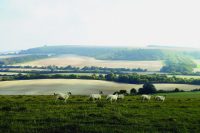Tax Relief on woodland: How to maximise your forestry tax breaks

14th January 2020
It’s fair to say that the woodlands activity on a farming enterprise is often overlooked in terms of accountancy and tax. However, with the increased commercial potential of woodland combined with the existing tax advantages, many farmers are having to question the current and potential usage of the woodland included in their farm.
Agricultural land values in the South West of the UK have been in and around £7,000-£12,000 per acre, so in most cases planting this land to woodland has previously been unattractive for farmers, as average land values for woodland have been in the region of £2,500-£5,000.
With increasing incentives to reduce our environmental impact, the grants and tax reliefs for owning and running a woodland are becoming more and more attractive. This, in turn, is also increasing the land value for woodland areas, which has soared over the past few years.
Available grants could save your farm 65%
There are a multitude of grants available for planting agricultural land to woodland, with these being up to as high as 80% of the cost of planting the trees, as well as grants being available on any fencing that is done to enclose the woodland area.
Here at Old Mill we have seen these grants being utilised, supporting a farming client who has created woodland using this grant and only incurring 35% of the costs to establish the trees and the fencing.
Basic Payment Scheme (BPS) – more grants around the corner?
In the current economic climate, with the disappearance of the Basic Payment Scheme (BPS) and the uncertainty around how the main farming grant will be replaced, there is the question as to whether woodland may end up receiving even more grants than it already does.
There has been speculation for some time that grants are likely to become based more and more on environmental grounds, and farmers will have to do more in these areas to receive the funding.
Agricultural Property Relief (APR) and Business Property Relief (BPR) benefits
Woodland also has the additional benefit of qualifying for Agricultural Property Relief (APR), and once owned for two years also benefits from Business Property Relief (BPR).
Compared to other diversification methods, such as residential and commercial lettings, office blocks and farm shops (which all qualify for APR), diversifying into the creation of a woodland does not affect any Inheritance Tax (IHT) reliefs for the farm. Instead it will more than likely increase the agricultural activity of the farm and the likelihood of gaining APR.
Timber can be exempt from Income Tax
Once the timber crop is established, the sale of any timber currently benefits from an exemption to Income Tax and therefore is not a taxable source of income. This does mean that costs associated with establishing the crop are also not tax deductible, but if this is operated at a profit-making level then the net outcome is a gain for the landowner in not having to pay Income Tax on their profits.
Remember, in order for the reliefs mentioned above to be available, the woodland must be run commercially and cannot be solely used for recreational purposes.
In this instance, commercial activity can be defined as forest schools, paintballing, ‘glamping with tree houses’ or maximising off-road driving. These can then also benefit from Holdover Relief, CGT Rollover Relief and Entrepreneurs’ Relief (ER) as long as the woodlands and the business within them are sold or valued as one entity, and the business that uses them qualifies for the CGT reliefs.
If you would like help on any of the topics above then feel free to get in touch with us or find out more about our accounting services for farms.


